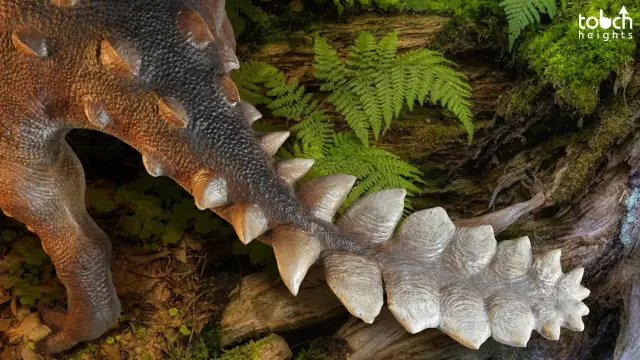It’s not every day that you come across a dinosaur that used a wholly new weapon to protect itself from predators.
Chilean researchers revealed the discovery of a new species of ankylosaur, a family of dinosaurs famed for its hefty armor, from subantarctic Chile in a paper published Wednesday in Nature. The species, dubbed Stegouros elengassen, provides fresh information on the origins of these tank-like dinosaurs, as well as a strange, bony tail formed like an Aztec warrior’s club.
“It lacks most of the characteristics we’d anticipate from an ankylosaur and has a completely unusual tail weapon, indicating that something distinctive is occurring here in South America,” said Alexander Vargas, a professor at the University of Chile and co-author of the paper.
Ankylosaurs of various types originally roamed in large numbers over Laurasia, the northern supercontinent that once included North America and Asia. Even among species known for their creative protection strategies, the ankylosaur family distinguishes remarkable.

The mid-Jurassic split between the stegosaurs, their closest relatives, and the ankylosaurs, which acquired skins coated with bone deposits known as osteoderms that created lattices of tooth-breaking armor. The most well-known ankylosaur species had shin-shattering tail clubs that resembled the ancient warriors’ maces.
However, Dr. Vargas said that little is known about their cousins from Gondwana’s southern continent, which is now South America and Antarctica. The origins and early evolution of the family have remained a mystery for a very long time since these are thought to contain the first members of the group. A group of paleontologists from the University of Texas discovered a pair of bones in February 2018 in the chilly, wind-swept valley of Rio Las Chinas, near Chile’s southernmost tip. Despite being intimidating, the location serves as a guide for paleontologists:
Dr. Vargas has spent the last ten years researching there, dating rocks and seeking fossil hotspots alongside researchers like Marcelo Leppe from the Chilean Antarctic Institute.
When the Texas paleontologists informed Dr. Vargas and Dr. Leppe of the discovery, there were just five days remaining in the field season. They dragged the slab of fossils downhill to the campground while laboring through the night in the bitter cold. A rib was broken and an ankle was sprained by two different people. Many individuals were almost hypothermic.
However, what emerged from the block was worthwhile. An extraordinarily complete ankylosaur was discovered during preparation: 80 percent of the skeleton, including a considerable portion of the back that is articulated, as well as vertebrae, shoulders, forelimbs, and fragments of the head.
This Chilean dinosaur was discovered with a battle-axe tail
Stegosaurus had a length of about six feet, a proportionately large head, slender limbs, and an oddly short tail that was tipped with seven pairs of flattened, bony osteoderms that form a single structure. That tail weapon appears to have developed independently of other ankylosaurs since Dr. Vargas compared it to a macuahuitl, the obsidian-studded bladed club used by Mesoamerican warriors. Early northern ankylosaurs lacked tail clubs, but later species acquired them as a result of the evolution of stiffened vertebrae, which served as the “handle” of the blunt tail club.

Ankylosaurs of all kinds did, however, formerly wander Laurasia in great numbers. It is the remnant of the northern supercontinent that once included Asia and North America. The ankylosaur family, therefore, distinguishes apart even within a group of creatures renowned for their creative defense mechanisms. The skins of ankylosaurs were coated with osteoderms or bone deposits. After separating from their closest relatives, the stegosaurs, in the mid-Jurassic, developed lattices of tooth-breaking armor.
The most well-known ankylosaur evolved shin-breaking tail clubs, resembling the maces of early warriors.
The family’s beginnings and early growth are still unknown, even though these are believed to be the family’s first members. In the chilly, wind-blasted valley of Ro Las Chinas, a group of paleontologists from the University of Texas found a pair of bones. In February 2018, it may be seen on Chile’s southernmost point. Despite its threatening appearance, the location is a haven for paleontologists: Dr. Vargas has spent the last ten years there with researchers like Marcelo Leppe from the Chilean Antarctic Institute dating rocks and searching for fossil hotspots.
Bottom Line:
Only five days remained in the field season when the Texas paleontologists alerted Dr. Vargas and Dr. Leppe of the discovery. They moved the fossil block to the campground at night in the cold. One guy shattered a rib, while another sustained an ankle strain. Numerous individuals came perilously near hypothermia. But what emerged off the butcher block was well worthwhile. Ankylosaurs were discovered to have an extraordinarily complete skeleton after preparation: 80% of the skeleton, which included a considerable portion of the back was articulated, as well as vertebrae, shoulders, forelimbs, and skull fragments.






